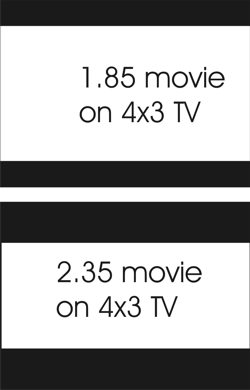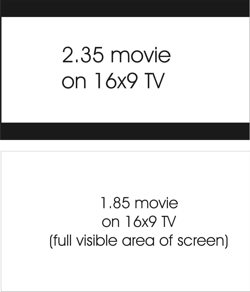
Distance Education In the TV World, or
How Far Back Should You Sit?
by Jim Bray
Aren't big screens great? Big screens help you bring the cinema experience
into your home, and if coupled to a high definition signal or DVD player you
can actually get a better picture than in your local cineplex.
Deciding what size of TV will suit you best – and will fit into your
room best – can be be tough. One of the questions you should answer is:
How far back from the TV should you sit?
This is difficult to answer scientifically but, fortunately, it doesn't really
matter in the Grand Scheme of Things.
It wasn't always this way, of course, in the days of lower resolution big
screens when you had to deal with scan lines, but in this day of digital HDTV-ready
sets the problem of how far back to sit isn't as important.
If you want something kind of official, the Society of Motion Picture and
Television Engineers (SMPTE) recommends a screen size that lets you see 30 degrees
of viewing angle (side to side) from where you sit.
Now all you need to do is translate that into English!
Don't sweat it excessively. It's all relatively arbitrary and, while there
may be optimum viewing distances for particular screens, you may be willing
to sacrifice some “optimum” for the “wow factor.”

For example, in the nearly-departed days of analog TV, when I was planning
to buy a big screen TV, I leaned toward a 61 inch 4x3 screen even though a 53
incher would better suit my particular viewing room. My rationale was that,
even though I'd lose some apparent detail and be even more annoyed by scan lines
than if I'd sat back a bit farther, the larger screen would fill my field of
vision better and create a more cinematic experience. And I wanted a screen
that would give me the best picture size possible with widescreen sources, since
I care more about movies than TV programs. Achieving that goald required a larger
4x3 screen than I might have bought otherwise.
In the end, I bought a 57 inch 16x9 HD-ready set. Its screen size would be
approximately comparable to a 46 inch 4x3 “narrowscreen” set, which
is a pretty good size for my viewing distance. And it's nothing short of spectacular
with widescreen material.
I would have loved to buy the comparable 65 inch version, but it wouldn't
have fit down the steps into my room, darn it.
Here's another rule of thumb for viewing distance: the Lazy Boy (the viewer,
not the chair!) should sit three to six screen widths from the TV. So a 57 inch
16x9 screen (which is approximately 48 inches wide) should be separated from
the easy chair by 144 to 288 inches (12 to 24 feet).
Yet in my current home theater I'm forced to sit no farther than about 8.5
feet from my 57 incher - and it looks great. It looks a bit better from farther
away, but that means leaving the room (which is silly) and it means a distinct
loss of that “Wow!” factor that I find important.
I can make out the pixels sometimes when watching a DVD or broadcast in 480p,
but it's a lot less annoying than those old fashioned scan lines and it doesn't
bother me at all; it just whets my appetite for the HD-DVD's that are just over
the horizon.
How does this distance factor factor in when you're talking about LCD, DLP
or plasma? Exactly the same: it's the screen size and distance that counts,
not the medium.
That's with today's technology. It wasn't always so. Older LCD projectors,
for example, tended to make the picture look as if you were watching through
a screen door, but thanks to improvements in quality and such digital gizmos
as line doubling this isn't such a problem any more.
Then there's “apparent” screen size, which comes into play when
comparing a 4x3 TV with a 16x9.
Anamorphic widescreen movies look far larger (and more satisfying) on a 16x9
TV than on a comparable 4x3 TV. In fact, they look bigger on a 16x9 TV than
on a larger 4x3 (within reason).
For example, the picture from a DVD using the 1.85:1 aspect ratio played on
a 36 inch 4x3 TV fills a 28” x 17” rectangle on the screen, whereas
the same DVD played on a widescreen 34 inch display fills a rectangle about
32 x 18 inches.
The 2.35:1 aspect ratio also fills the 16x9 screen better. A 2.35:1 picture
on a 4x3 set only uses about half the screen area, whereas on a 16x9 TV it fills
a “guesstimated” 75 per cent. And of course 1.85:1 fills the 16x9
screen completely, which is really a rush!
This is a nice selling point for people who don't like those black bars from
widescreen movies: a 2.35:1 movie on a 16x9 TV only has bars about the same
size as a 1.85:1 letterboxed movie on a 4x3 TV. They're much easier to live
with!
The bottom line is that you can confidently buy the largest 16x9 television
you can fit comfortably into their room, within reason. Questions of optimal
viewing distances are more related to “old tech” non-digital TV's
with scan lines and don't apply nearly as much to today's digital TV's.
But when you're in the store, look at the various TV's from approximately
the same distance – and height - from the floor samples as the TV would
be at home, then pick the size works best for you.
And don't forget to mention that, when it comes to rear projectors, you need
to get the TV into the room as well (the reason I couldn't buy a 65 incher)!
Good luck!
PS: If finding your optimum viewing distance is really important you you,
there's a Web page here that can calculate “optimum”
viewing distance for a variety of parameters.
Tell us at TechnoFile what YOU think




